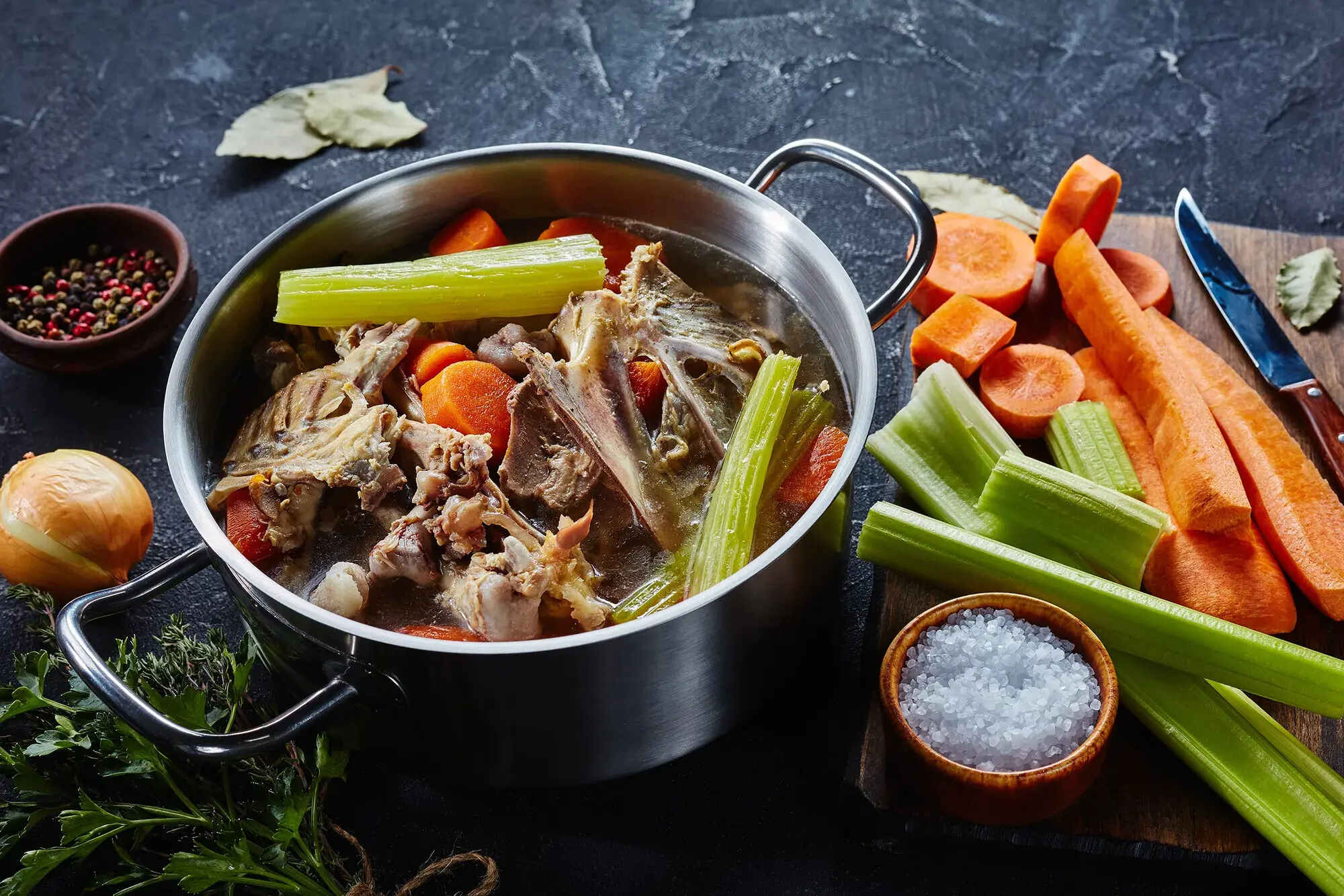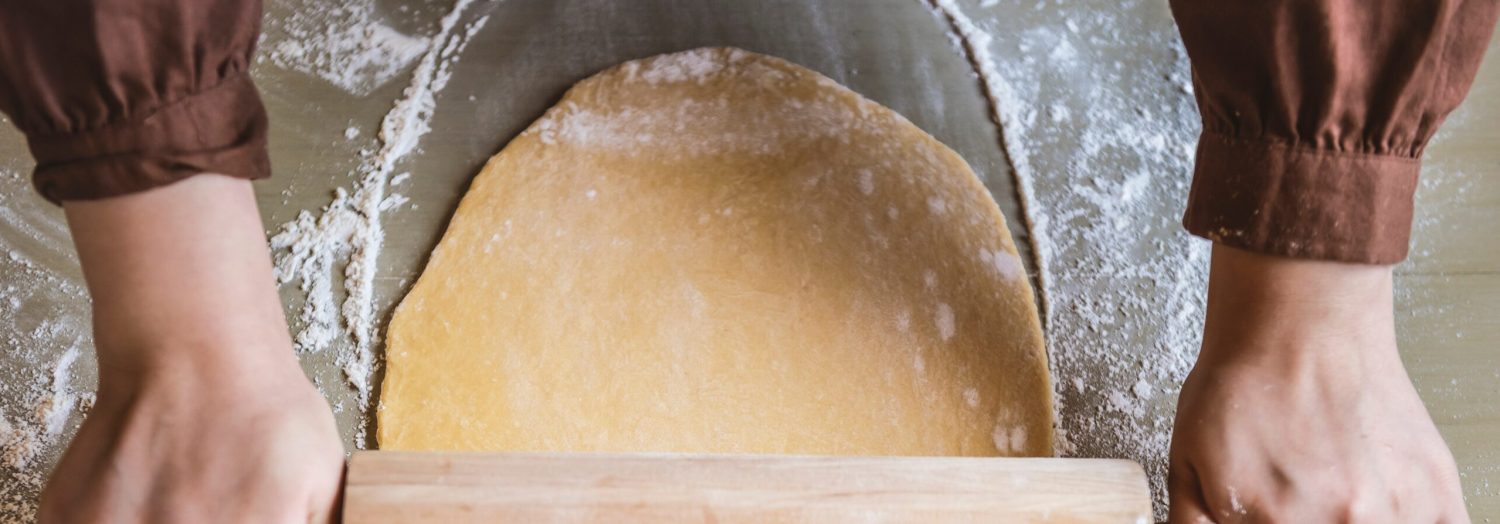Creating a rich and nourishing bone broth is a time-honored tradition that brings deep flavors and numerous health benefits. This recipe will guide you through the process of making a hearty broth that can be used as a base for soups, stews, or enjoyed on its own.
When preparing this bone broth, you might need to visit a supermarket for a few specific ingredients. Beef bones, especially those with marrow, are essential for a rich flavor and are often found in the meat section. Apple cider vinegar is another key ingredient that helps extract nutrients from the bones. Ensure you have these on hand before starting.

Ingredients For Bone Broth Recipe
Beef bones: Essential for creating a rich and flavorful broth. Preferably use bones with marrow for added nutrients.
Onion: Adds depth and sweetness to the broth.
Carrots: Provides a natural sweetness and enhances the flavor profile.
Celery: Adds a subtle, earthy flavor to the broth.
Garlic: Infuses the broth with a robust, aromatic quality.
Apple cider vinegar: Helps extract minerals from the bones and adds a slight tang.
Salt: Enhances the overall flavor of the broth.
Pepper: Adds a hint of spice and complexity.
Water: The base liquid that transforms the ingredients into a nourishing broth.
Technique Tip for Making Broth
To enhance the flavor of your bone broth, consider adding a variety of herbs and spices during the simmering process. Fresh thyme, rosemary, and bay leaves can add depth and complexity to the broth. Additionally, a splash of soy sauce or a few dried mushrooms can introduce umami notes, making the broth even more savory and rich.
Suggested Side Dishes
Alternative Ingredients
beef bones - Substitute with chicken bones: Chicken bones can provide a similar depth of flavor and are often more readily available.
beef bones - Substitute with pork bones: Pork bones can also offer a rich, hearty flavor, though it will be slightly different from beef.
onion - Substitute with leeks: Leeks provide a milder, sweeter flavor that can complement the broth well.
onion - Substitute with shallots: Shallots offer a more delicate and slightly sweeter taste compared to onions.
carrots - Substitute with parsnips: Parsnips have a similar texture and sweetness, making them a good alternative.
carrots - Substitute with sweet potatoes: Sweet potatoes add a different kind of sweetness and a slightly different texture.
celery - Substitute with fennel: Fennel provides a slightly anise-like flavor that can add complexity to the broth.
celery - Substitute with bok choy: Bok choy offers a similar crunch and mild flavor.
garlic - Substitute with shallots: Shallots can provide a similar aromatic quality, though they are milder.
garlic - Substitute with ginger: Ginger adds a different but complementary flavor profile, offering warmth and spice.
apple cider vinegar - Substitute with white wine vinegar: White wine vinegar provides a similar acidity and can help extract flavors from the bones.
apple cider vinegar - Substitute with lemon juice: Lemon juice offers a fresh acidity that can also help in extracting flavors.
salt - Substitute with soy sauce: Soy sauce adds saltiness along with umami, enriching the broth's flavor.
salt - Substitute with miso paste: Miso paste provides saltiness and a deep umami flavor.
pepper - Substitute with cayenne pepper: Cayenne pepper adds heat and a slightly different kind of spice.
pepper - Substitute with paprika: Paprika provides a milder heat and a smoky flavor.
water - Substitute with vegetable broth: Vegetable broth adds additional layers of flavor to the final product.
water - Substitute with chicken broth: Chicken broth can enhance the overall flavor profile of the bone broth.
Alternative Recipes Similar to This Broth
How to Store or Freeze Your Broth
- Allow the bone broth to cool to room temperature. This helps prevent condensation inside storage containers, which can dilute the broth and affect its flavor.
- Use airtight containers or mason jars for storing the broth in the refrigerator. Make sure to leave about an inch of space at the top to allow for expansion if you plan to freeze it later.
- Label each container with the date and contents. This will help you keep track of freshness and ensure you use the oldest broth first.
- For freezing, consider using silicone ice cube trays or muffin tins to create individual portions. Once frozen, transfer the cubes to a freezer bag or airtight container. This method allows you to easily use small amounts of broth as needed.
- If using larger containers for freezing, ensure they are freezer-safe and leave extra space for expansion. Glass containers should be tempered to avoid cracking.
- Store the broth in the refrigerator for up to 5 days. For longer storage, keep it in the freezer for up to 6 months.
- When reheating, bring the broth to a boil to ensure it is heated through and safe to consume. You can add fresh herbs or vegetables to enhance the flavor if desired.
- Avoid refreezing thawed broth, as this can degrade its quality and flavor. Instead, portion out only what you need to avoid waste.
- If you notice any off smells, discoloration, or mold, discard the broth immediately. Proper storage and handling are key to maintaining the quality and safety of your bone broth.
How to Reheat Leftovers
Stovetop method: Pour the bone broth into a saucepan and heat over medium heat. Stir occasionally until it reaches your desired temperature. This method ensures even heating and allows you to adjust the seasoning if needed.
Microwave method: Place the bone broth in a microwave-safe container. Cover it loosely with a microwave-safe lid or plastic wrap. Heat on high for 1-2 minutes, stirring halfway through. Be cautious as the container can get very hot.
Slow cooker method: Pour the bone broth into your slow cooker and set it to low. Allow it to heat for about 1-2 hours. This method is perfect if you want to keep the broth warm for an extended period.
Double boiler method: Fill a large pot with water and bring it to a simmer. Place a heatproof bowl with the bone broth on top of the pot, ensuring the bottom of the bowl doesn't touch the water. Stir occasionally until the broth is heated through. This gentle method prevents the broth from scorching.
Immersion blender method: If you have an immersion blender, you can use it to reheat and blend the bone broth directly in the pot. This method is great for incorporating any remaining bits of vegetables or meat into the broth, making it even more flavorful.
Essential Tools for Making Broth
Baking sheet: Used to roast the beef bones in the oven, which helps to enhance their flavor.
Large pot: Necessary for simmering the bones and vegetables together to create the broth.
Fine-mesh strainer: Essential for straining the broth to remove the solids and achieve a clear liquid.
Knife: Used for chopping the vegetables like onions, carrots, and celery.
Cutting board: Provides a safe surface for chopping the vegetables.
Oven: Required to preheat and roast the beef bones.
Stove: Needed to bring the water to a boil and then simmer the broth.
Spoon: Useful for skimming foam off the top of the simmering broth.
Measuring spoons: Used to measure out the apple cider vinegar, salt, and pepper.
Refrigerator: Necessary for cooling and storing the broth after it has been strained.
Time-Saving Tips for Making Broth
Roast in bulk: Roast extra beef bones and vegetables at once, then freeze for future batches.
Use a slow cooker: Set it and forget it. A slow cooker can simmer your bone broth while you focus on other tasks.
Pre-chop ingredients: Chop onions, carrots, and celery in advance and store them in the fridge.
Skim less frequently: Skim the foam every few hours instead of constantly, saving you time and effort.
Quick cool down: Use an ice bath to cool the broth faster before refrigerating.

Bone Broth Recipe
Ingredients
Main Ingredients
- 2 lbs beef bones preferably with marrow
- 1 onion quartered
- 2 carrots chopped
- 2 stalks celery chopped
- 3 cloves garlic smashed
- 2 tablespoon apple cider vinegar
- 1 teaspoon salt to taste
- 1 teaspoon pepper to taste
- 16 cups water
Instructions
- 1. Preheat oven to 400°F (200°C). Place beef bones on a baking sheet and roast for 30 minutes.
- 2. Transfer roasted bones to a large pot. Add onion, carrots, celery, garlic, apple cider vinegar, salt, and pepper.
- 3. Pour in water and bring to a boil. Reduce heat and simmer for 8-24 hours, skimming foam occasionally.
- 4. Strain broth through a fine-mesh strainer. Discard solids. Let broth cool and refrigerate.
Nutritional Value
Keywords
More Amazing Recipes to Try 🙂
- Fruit Salad Recipe15 Minutes
- Baby Back Ribs Recipe2 Hours 15 Minutes
- Sinigang na Isda sa Miso Recipe45 Minutes
- Beer Can Chicken Recipe1 Hours 45 Minutes
- Japanese Tamago Egg Recipe20 Minutes
- Chinese Chicken Fried Rice Recipe30 Minutes
- Party Pinwheels Recipe15 Minutes
- Panzanella Salad Recipe15 Minutes

Leave a Reply